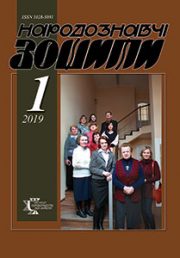The Ethnology Notebooks. 2021. № 3 (159), 601—605
UDK 94(477.83-25)”19″:629.433(036)
DOI https://doi.org/10.15407/nz2021.03.601
МОVNА Мarianna
- ORCID ID: http://orcid.org/0000-0003-2473-6998
- Candidate of Historical Sciences,
- Junior Researcher of the Vasyl Stefanyk
- National Scientific Library of Ukraine in Lviv
- National Academy of Sciences of Ukraine,
- in Department of Scientific Bibliography,
- 2, Stefanyka str., 79000, Lviv, Ukraine,
- Contacts: e-mail: mari3anna@ukr.net
Abstract. The article for the first time analyzes the factual content of specialized guides with tram tracks of Lviv in the early XX century. As a modern mode of transport, the tram immediately after its appearance in 1894 came to the attention of the authors of city guides, both general and specially dedicated to electric tracks. The first specialized guide for the city’s tram lines was the «Lviv Electric Tram Guide» (1913).
The object of research is Lviv as a cultural and mental category, and the subject — guides by Lviv tram. The research methodology is based on the application of the principles of scientificity, objectivity and historicism. In order to solve specific research tasks, a comparative-historical, typological, method of historical reconstruction, problem-chronological, discourse-analysis was used. The study of guides on Lviv tram tracks has never been the subject of special consideration. Moreover, even the history of the Lviv tram, despite its unconditional attractiveness, did not often come into the field of view of researchers — both Ukrainian and Polish.
The electric tram appeared on the streets of Lviv on May 31, 1894 — the fourth in Austria-Hungary after Vienna (1883), Budapest (1887) and Prague (1891) on the occasion of the opening of the general National Exhibition — a harbinger of the future economic rise of Galicia at the turn of XIX and XX century. The first tram line was laid along the route «Main Station — Hetman’s Walls — Stryj Park».
Specialized guides to the tram, which was a relatively new and popular for Lviv mode of transport, which appeared on the demand of time, reflected the state of technical progress of the early twentieth century. These guides were intended both for citizens and for numerous guests of Lviv; they properly performed the function of information support, acquainting the reader not only with the transport infrastructure, but also with the city as a whole, expanding its cultural horizons.
Keywords: guide, tram, Lviv, history, route, early XX century.
Received 20.04.2021
REFERENCES
- Nadraha, O., & Kurilishin, K. (2004). Among Lviv parks. Lviv: Pyramida [in Ukrainian].
- Tarkhov, S.A. (1994). History of the Lviv tram. Lviv: Phoenix [in Ukrainian].
- Szajner, J., & Rehtovich, M. (2020). Lviv trams 1880–1944. Lodz [in Polish].
- (1913). Guide to Lviv by electric rail. Lviv [in Polish].
- Lem, S. (2002). High Castle. Lviv: Pyramida [in Ukrainian].
- (1913). A guide for those who ride the Lviv tram. Gazeta Wieczorna, 1068, 5 [in Polish].
- (1913). Guide to Lviv by electric rail. Kurjer Lwowski, 3, 2 [in Polish].
- (1913). Guide to Lviv by electric rail. Slowo Polskie, 14, 6 [in Polish].
- Werner, W. (Ed.). (1914). A guide to Lviv electric rail with a gift card for 1914. Lviv [in Polish].
- Janusz, B. (1915). 293 days of Russian rule in Lviv (September 3, 1914 — June 22, 1915). Lviv; Warsaw [in Polish].
- (1915). How to use trams. Lvov [in Russian].
- Movna, M.V. (2020). Lviv in tourist guides of the second half of the XIX — first third of the XX century: abstract for the degree of candidate of historical sciences: 07.00.01 — «History of Ukraine»; LNU named after I. Franko [in Ukrainian].






